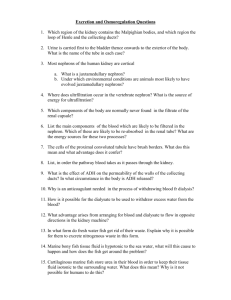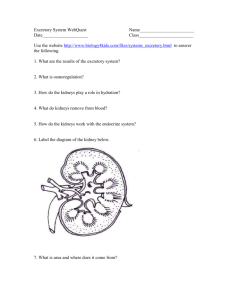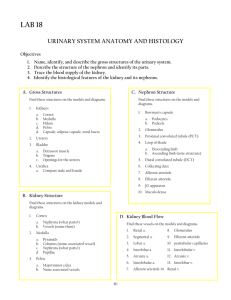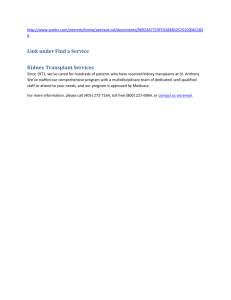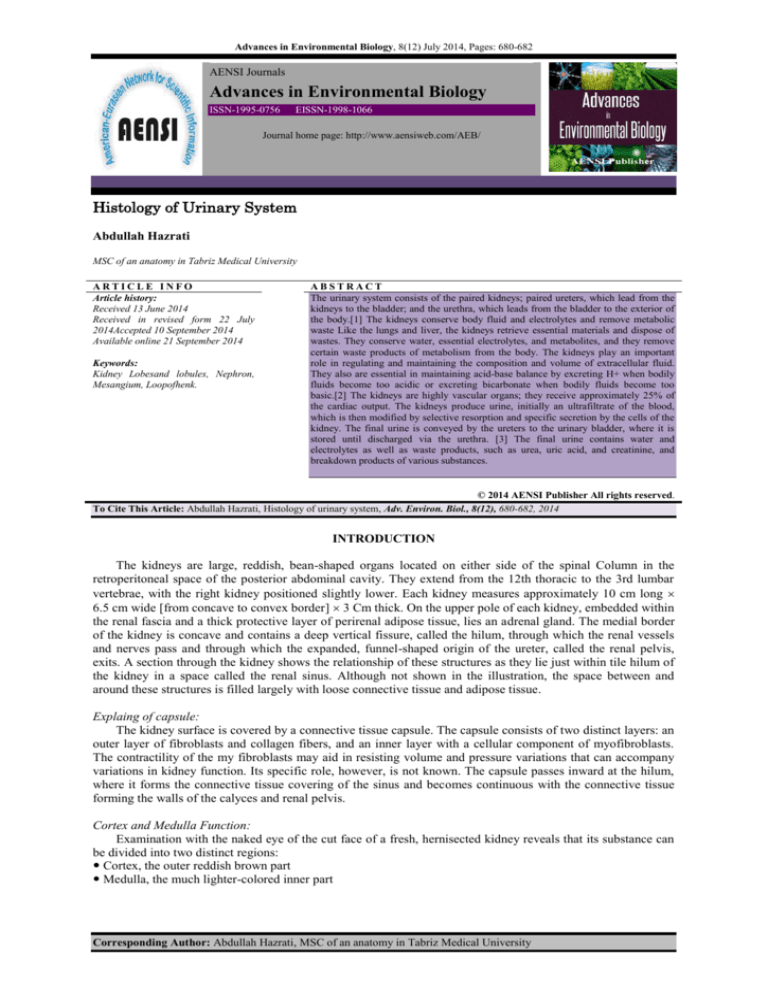
Advances in Environmental Biology, 8(12) July 2014, Pages: 680-682
AENSI Journals
Advances in Environmental Biology
ISSN-1995-0756
EISSN-1998-1066
Journal home page: http://www.aensiweb.com/AEB/
Histology of Urinary System
Abdullah Hazrati
MSC of an anatomy in Tabriz Medical University
ARTICLE INFO
Article history:
Received 13 June 2014
Received in revised form 22 July
2014Accepted 10 September 2014
Available online 21 September 2014
Keywords:
Kidney Lobesand lobules, Nephron,
Mesangium, Loopofhenk.
ABSTRACT
The urinary system consists of the paired kidneys; paired ureters, which lead from the
kidneys to the bladder; and the urethra, which leads from the bladder to the exterior of
the body.[1] The kidneys conserve body fluid and electrolytes and remove metabolic
waste Like the lungs and liver, the kidneys retrieve essential materials and dispose of
wastes. They conserve water, essential electrolytes, and metabolites, and they remove
certain waste products of metabolism from the body. The kidneys play an important
role in regulating and maintaining the composition and volume of extracellular fluid.
They also are essential in maintaining acid-base balance by excreting H+ when bodily
fluids become too acidic or excreting bicarbonate when bodily fluids become too
basic.[2] The kidneys are highly vascular organs; they receive approximately 25% of
the cardiac output. The kidneys produce urine, initially an ultrafiltrate of the blood,
which is then modified by selective resorption and specific secretion by the cells of the
kidney. The final urine is conveyed by the ureters to the urinary bladder, where it is
stored until discharged via the urethra. [3] The final urine contains water and
electrolytes as well as waste products, such as urea, uric acid, and creatinine, and
breakdown products of various substances.
© 2014 AENSI Publisher All rights reserved.
To Cite This Article: Abdullah Hazrati, Histology of urinary system, Adv. Environ. Biol., 8(12), 680-682, 2014
INTRODUCTION
The kidneys are large, reddish, bean-shaped organs located on either side of the spinal Column in the
retroperitoneal space of the posterior abdominal cavity. They extend from the 12th thoracic to the 3rd lumbar
vertebrae, with the right kidney positioned slightly lower. Each kidney measures approximately 10 cm long
6.5 cm wide [from concave to convex border] 3 Cm thick. On the upper pole of each kidney, embedded within
the renal fascia and a thick protective layer of perirenal adipose tissue, lies an adrenal gland. The medial border
of the kidney is concave and contains a deep vertical fissure, called the hilum, through which the renal vessels
and nerves pass and through which the expanded, funnel-shaped origin of the ureter, called the renal pelvis,
exits. A section through the kidney shows the relationship of these structures as they lie just within tile hilum of
the kidney in a space called the renal sinus. Although not shown in the illustration, the space between and
around these structures is filled largely with loose connective tissue and adipose tissue.
Explaing of capsule:
The kidney surface is covered by a connective tissue capsule. The capsule consists of two distinct layers: an
outer layer of fibroblasts and collagen fibers, and an inner layer with a cellular component of myofibroblasts.
The contractility of the my fibroblasts may aid in resisting volume and pressure variations that can accompany
variations in kidney function. Its specific role, however, is not known. The capsule passes inward at the hilum,
where it forms the connective tissue covering of the sinus and becomes continuous with the connective tissue
forming the walls of the calyces and renal pelvis.
Cortex and Medulla Function:
Examination with the naked eye of the cut face of a fresh, hernisected kidney reveals that its substance can
be divided into two distinct regions:
Cortex, the outer reddish brown part
Medulla, the much lighter-colored inner part
Corresponding Author: Abdullah Hazrati, MSC of an anatomy in Tabriz Medical University
681
Abdullah Hazrati, 2014
Advances in Environmental Biology, 8(12) July 2014, Pages: 680-682
The color seen in the cut surface of the unfixed kidney reflects the distribution of blood in the organ.
Approximately 90 to 95% of the blood passing through the kidney is in the cortex; 5 to 10% is in the medulla
[3].
The cortex is characterized by renal corpuscles and their associated tubules:
The cortex consists of renal corpuscles along with the convoluted and straight tubules of the nephron, the
collecting tubules, collecting ducts, and an extensive vascular supply. The nephron is the basic functional unit of
the kidney and is described below. The renal corpuscles are spherical structures, barely visible with the naked
eye. They constitute the beginning segment of the nephron and contain a unique capillary network called a
glomerulus [2].
Examination of a section cut through the cortex at an angle perpendicular to the surface of the kidney
reveals a series of vertical striations that appear to emanate from the medulla These striations are the medullary
rays [of Ferrein]. Their name reflects their appearance, as the striations seem to radiate from the medulla.
Approximately 400 to 500 medullary rays project into the cortex from the medulla.
Each medullary ray is an aggregation of straight tubules and collecting ducts:
Each medullary ray contains straight tubules of the nephrons and collecting ducts. The regions between
medullary rays contain the renal corpuscles, the convoluted tubules of the nephrons, and the collecting tubules.
Kidney Lobes and Lobules:
The number of lobes in a kidney equals the number of medullary pyramids:
Each medullary pyramid and the associated cortical tissue at its base and sides [one half of each adjacent
renal column] constitutes a lobe of the kidney. The lobar organization of the kidney is conspicuous in the
developing fetal kidney Each lobe is reflected as a convexity on the outer surface of the organ, but they usually
disappear after birth. The surface convexities typical of the fetal kidney may persist, however, until the teenage
years and, in some cases, into adulthood. Each human kidney contains 8 to t8 lobes. Kidneys of some animals
possess only one pyramid; these kidneys are classified as unilobar, in contrast to the multilobar kidney of the
human [3].
Describtion of Nephron and General organization of the Nephron:
The nephron is the structural and functional unit of the kidney:
The nephron is the fundamental structural and functional unit of the kidney. Each human kidney contains
approximately 2 million nephrons. Nephrons are responsible for the production of urine and correspond to the
secretory part of other glands. The collecting ducts are responsible for the final concentration of the urine and
are analogous to the ducts of exocrine glands that modify tile concentration of the secretory product. Unlike the
typical exocrine gland in which the secretory and duct portions arise from a single epithelial outgrowth,
nephrons and their collecting tubules arise from separate primordia and only later become connected [2].
General Organization of the Nephron:
The nephron consists of the renal corpuscle and a tubule system:
As stated above, the renal corpuscle represents the beginning of the nephron. It consists of the glomerulus, a
tuft of capillaries composed of 10 to 20 capillary loops, surrounded by a double-layered epithelial cup, the renal
or Bowman's capsule. Bowman's capsule is the initial portion of the nephron where blood flowing through the
glomerular capillaries undergoes filtration to produce the glomerular ultrafiltrate. The glomerular capillaries are
supplied by an afferent arieriole and are drained by an efferent arteriole that then branches, forming a new
capillary network to supply the kidney tubules. The site where the afferent and efferent arterioles penetrate and
exit from the parietal layer of Bowman's capsule is called the vascular pole. Opposite this site is the urinary pole
of the renal corpuscle, where the proximal convoluted tubule begins [3].
Continuing from Bowman's capsule, the remaining parts of the nephron [the tubular parts] are
Proximal thick segment, consisting Of the proximal convoluted tubule [pars convoluta] and the proximal
straight tubule [pars recta]
Thin segment, which constitutes the thin part of the loop of Henle
Distal thick segment, consisting of the distal straight tubule [pars recta] and the distal convoluted tubule [pars
convolute]
The distal convoluted tubule connects to the collecting tubule, often through a connecting tubule, thus forming
the uriniferous tubule, i.e., the nephron plus collecting tubule.
Conclusions:
1. The renal corpuscle is spherical and has an average diameter of 200 m . It consists of the glomerular
capillary tuft and the surrounding visceral and parietal epithelial layers of Bowman's capsule.
682
Abdullah Hazrati, 2014
Advances in Environmental Biology, 8(12) July 2014, Pages: 680-682
2. The collecting tubules begin in the cortical labyrinth, as either connecting tubules or arched collecting
tubules, and proceed to the medullary ray where they join the collecting ducts. The collecting duets within the
cortex are referred to as cortical collecting ducts.
3. Visceral layer of Bowman's capsule, which contains specialized cells called podocytes or visceral epithelial
cells. These cells extend processes around the glomerular capillaries.
REFERENCES
[1] Barr, M.L., 1979. The Human Nervous System. New York: Harper & Row.
[2] Barr, M.L., J.A. Kiernan, 1983. The Human Nervous System. New York: Harper & Row.
[3] Fuller, G.N., P.C. Burger, 1997. Central nervous system. In: Sternberg S5, ed Histology for Pathologists.
Philadelphia: Lippincott-Raven.

